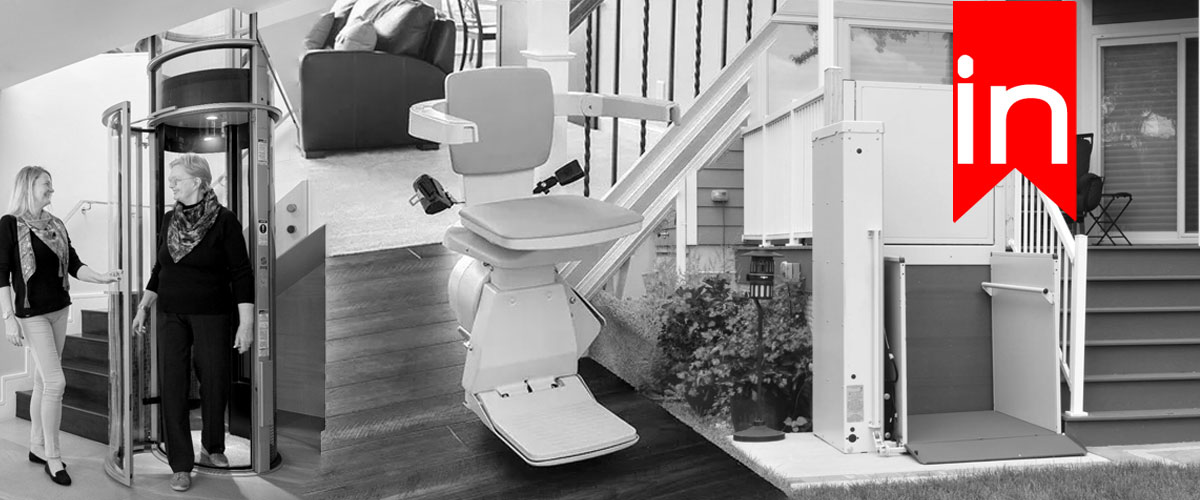In a world where aging in place is becoming increasingly feasible, homeowners grappling with mobility challenges are presented with a diverse array of solutions designed to enrich their home accessibility. Among these options, stair lifts, platform lifts, and home elevators emerge as standout choices, each offering a unique set of advantages and considerations. These innovative solutions not only address the physical barriers posed by stairs and multi-level homes but also empower individuals to maintain their independence, reclaim their sense of freedom, and curate an environment that fosters a higher quality of life. In the following discussion, we will delve into the nuances of these options, guiding homeowners toward informed decisions that align with their specific needs and aspirations.
Stair lifts are a cost-effective option for individuals who can sit or stand but struggle with stairs. They are suitable for straight staircases and come in indoor and outdoor models, offering versatility. However, they may not accommodate wheelchair or scooter users. Typically, they provide access to a single level.
Vertical Platform lifts offer wheelchair and scooter accessibility but come at a higher cost compared to stair lifts. Available in both indoors or outdoors models. Note that they require more space, which may be impractical for smaller homes. Typically, they provide access to a single level.
Home elevators provide a permanent solution, ideal for multi-story homes. They come in various sizes and designs, allowing homeowners to tailor them to their preferences. While elevators add value to a property, they are a more substantial investment than platform lifts or stair lifts. Typically, they provide access to multi-levels.
Stair lifts are budget-friendly for those navigating stairs with minimal assistance, while platform lifts offer wheelchair accessibility at a higher cost. Home elevators provide a permanent, customizable solution but come with a larger price tag. Choose the option that aligns best with your specific needs and budget constraints.
Highlights
- Stair lifts, platform lifts, and home elevators are highlighted as effective solutions for enhancing home accessibility, especially beneficial for seniors aiming to age in place. These options cater to varying mobility challenges, offering independence and improved quality of life.
- The affordability and suitability of stair lifts, platform lifts, and home elevators vary, with stair lifts being a cost-effective choice for those with mild mobility issues, platform lifts catering to wheelchair users, and elevators offering a comprehensive solution for multi-level home access.
- Implementing these mobility aids requires consideration of the individual’s specific needs, home layout, and budget, with stair lifts presenting the least expensive option, followed by platform lifts, and elevators being the most substantial investment yet providing significant value and convenience.
Understanding Mobility Challenges
Mobility challenges, prevalent among seniors and those with disabilities, can impact independence and overall well-being. These challenges arise from various factors like aging, injuries, or illnesses. To enable aging in place successfully, it’s crucial to explore tailored solutions.
Three primary mobility aids – stair lifts, platform lifts, and elevators – offer distinct benefits based on individual needs, budget, and home layout.
- Stair Lifts: Ideal for those who can still sit or stand independently, stair lifts are cost-effective and easily customizable. They safely transport individuals up and down stairs, reducing physical strain and enhancing accessibility.
- Vertical Platform Lifts: Designed for wheelchair users or those unable to sit independently on a chair, platform lifts provide outdoor and indoor accessibility. They come in many different vertical styles, ensuring mobility and convenience.
- Home Elevators: Though the priciest option, elevators offer ultimate flexibility. They accommodate wheelchairs and those who can move independently, making them suitable for multi-story homes. Elevators come in various sizes and styles to fit individual needs and home layouts.
These mobility solutions empower seniors and individuals with disabilities to maintain independence, improve safety, and enjoy their homes while aging gracefully. Understanding these options is essential for those seeking to age in place, ensuring a high quality of life with dignity and comfort.
Stair Lifts
Stair lifts are a popular solution for seniors and people with disabilities who have difficulty climbing stairs. They are designed to allow individuals to safely and easily move up and down stairs without the need for physical exertion. Stair lifts typically come in two main types: straight and curved.
Straight stairlifts are designed for stairs that are in a straight line, while curved stairlifts are designed for stairs that have curves or bends. Both types of stairlifts are available in different models and brands, such as Stannah stairlifts, Bruno stair lifts, and others.
Stair lifts are equipped with a chair that rides along a rail that is attached to the stair treads. The chair is typically controlled by a joystick or button, which allows the user to move the chair up or down the stairs. Some stair lifts also come with safety features such as seat belts, power swivel, and weight capacity limits.
Benefits Of A Stair Lift
One of the advantages of stair lifts is that they are relatively easy to install and do not require extensive home modifications. They are also less expensive than other options such as platform lifts or elevators. However, there are some cons to consider as well. For example, stair lifts can be limited by the weight capacity and accessibility guidelines. Additionally, they may not be suitable for individuals who have difficulty transferring in and out of a chair.
Vertical Platform Lifts
Platform lifts are tailored to facilitate effortless access for individuals with disabilities and seniors. This versatile aid can be found in diverse settings such as homes, offices, and public buildings, where they streamline movement between floor levels. Vertical platform lifts (VPL) are also referred to as porch lifts.
VPL are invaluable for wheelchair and mobility scooter users navigating height and floor differences between ground and entryway. VPL are solutions that can integrate into interior spaces or exterior porches, decks, garages ensuring accessibility and safety during those Canadian winters.
VPL can cater to both residential and commercial needs, ensuring access to elevated areas like porches and decks. These lifts, the most prevalent type, are suitable for indoor or outdoor installation and exhibit varying weight capacities, with some models accommodating up to approximately 750 pounds. Typically, they serve a single floor.
Benefits Of Platform Lifts
One of the pros of platform lifts is that they are easy to install and require minimal home modification. They can be installed indoors or outdoors, and the installation process is usually quick and straightforward. Platform lifts are also designed to be user-friendly, making them easy to operate for people with disabilities and seniors. However, platform lifts also have some cons. One of the cons is that they can be expensive, especially if you need to install them in multiple locations. Additionally, platform lifts may not be suitable for all homes or buildings, especially those with limited space.
Home Elevators
Home elevators are a top choice for enhancing accessibility, catering to individuals with mobility aids such as wheelchairs and walkers while adhering to accessibility guidelines. Seniors may choose to install elevators in their homes for compelling reasons. Elevators offer enhanced mobility, eliminating the physical strain of stairs and promoting independence. They enable seniors to comfortably age in place, ensuring accessibility to all areas of their homes. Safety is paramount, as elevators mitigate the risk of falls associated with stairs. Furthermore, they provide convenience, sparing seniors from the effort of navigating steps and assisting with heavy items. Crucially, elevators accommodate wheelchair users, guaranteeing unrestricted mobility. As an investment, elevators can enhance property value and, most importantly, significantly improve seniors’ overall quality of life by preserving their independence and freedom.
Benefits Of Home Elevators
Their key benefits include swift inter-floor transportation, customizable designs tailored to user needs, and versatility in fitting various spaces. However, home elevator installation can be costly and requires regular maintenance to ensure safety. Home elevators incorporate multiple safety features, including emergency stops, backup power, and intercom systems, along with weight capacity limits. To install a home elevator, collaboration with a specialized dealer is essential, as they can guide selection based on needs and budget, and assist in seamless home modifications. Ultimately, elevators offer seniors and individuals with disabilities a reliable, convenient means of accessing different building levels while maximizing space efficiency and ease of use.
Home Accessibility Outdoor and Indoor Options
When it comes to providing easy access for seniors and people with disabilities, there are several options available for both indoor and outdoor use. Stair lifts, platform lifts, and elevators are just a few of the choices that can be installed to improve accessibility in homes and buildings.
Indoor Options
For indoor use, stair lifts and platform lifts are popular choices. Stair lifts are a cost-effective solution that can be installed on straight or curved staircases. Platform lifts, on the other hand, are designed for wheelchair users and can be used to travel between floors. They are more expensive than stair lifts but provide greater accessibility. Elevators provide the most accessibility with multi-purpose functions; however, this method is limited to existing homes, and also has a significant cost to it.
Outdoor Options
For outdoor use, platform lifts (aka porch lifts) are the most common options. Ramps are a cost-effective solution that can be installed to provide easy access to homes and buildings.Platform lifts, on the other hand, are designed for wheelchair users and can be used to travel between levels. They are more expensive than ramps but provide greater accessibility.
Accessibility Guidelines
In Canada, stair lifts, platform lifts, and home elevators must adhere to various safety and accessibility guidelines and regulations to ensure their safe operation. These guidelines can vary by province and territory, but some common ones include:
- Canadian Standards Association (CSA): The CSA Group is responsible for developing and maintaining safety and performance standards for a wide range of products, including mobility devices like stair lifts, platform lifts, and home elevators. These standards ensure that the equipment meets safety and quality requirements.
- Building Codes: Building codes and regulations in Canada, such as the National Building Code (NBC) and provincial or territorial building codes, such as the Ontario Building Code (OBC), may specify requirements for the installation and use of mobility devices within residential and commercial properties. These codes may cover aspects like clearances, dimensions, and safety features.
- Accessibility Standards: Some provinces in Canada, like Ontario, have established accessibility standards and regulations under the Accessibility for Ontarians with Disabilities Act (AODA). These standards may include requirements for accessibility features, including those related to mobility devices.
- Local Regulations: Local municipalities may have their own regulations and bylaws that govern the installation and operation of mobility devices, so it’s important to check with local authorities for specific requirements in your area.
- Manufacturer’s Guidelines: Manufacturers of stair lifts, platform lifts, and home elevators typically provide guidelines for the installation and operation of their specific models. Following these guidelines is crucial to ensure the equipment functions safely and effectively.
- Regular Inspections and Maintenance: Periodic inspections and maintenance are often required to ensure that these devices continue to meet safety and operational standards in Canada.
It is extremely important to work with experienced professionals who are knowledgeable about local, provincial, and national regulations when installing these mobility devices in Canada to ensure they comply with all necessary requirements. This helps ensure the safety and accessibility of these devices for users with mobility challenges.
Comparing Costs and Affordability
When considering accessibility options for seniors and people with disabilities, cost is a major factor to consider. Stair lifts, platform lifts, and elevators all have different costs associated with them, and it is important to compare them to determine which option is most affordable.
Note that all prices can vary depending on location, models, availability, installation costs and any customization needed to your home. Speak to a professional for a quote for your specific needs.
Stair Lifts
Stair lifts are generally the most affordable option for home accessibility. The cost of a stair lift varies depending on the type of staircase, the length of the staircase, and the features of the lift. Straight stair lifts are typically less expensive than curved stair lifts, and basic models with minimal features are less expensive than those with more advanced features.
- Acorn Stairlifts straight stair lifts can cost CA $3,400+, curved stair lifts can cost CA $11,000+
- Bruno straight stair lifts can cost CA $4,000+, curved stair lifts can cost CA $15,000+
Vertical Platform Lifts
Vertical Platform Lifts can be a more expensive option than stair lifts, but they are still more affordable than home elevators. The cost of a platform lift depends on the type of lift, the height of the lift, and the features of the lift. Vertical platform lifts are typically less expensive than inclined platform lifts, and basic models with minimal features are less expensive than those with more advanced features.
- Bruno Vertical Platform Lift can cost CA $8,000+
- FlexStep by Liftup can cost CA $10,000+
Home Elevators
Home elevators are the most expensive option for home accessibility. The cost of an elevator depends on the type of elevator, the height of the elevator, and the features of the elevator. Hydraulic elevators are typically less expensive than traction elevators, and basic models with minimal features are less expensive than those with more advanced features.
- Savaria can cost CA $20,000+
- Garaventa Lift can cost CA $30,000
- Cambridge Elevating can cost $25,000+
- PVE can cost $30,000+
- Stiltz Lifts can cost $25,000+
Overall, stair lifts are the most affordable option for home accessibility, followed by vertical platform lifts and home elevators. When considering affordability, it is important to compare the installation costs, construction costs, and overall cost-effectiveness of each option.
The Best Options for Aging in Place Accessibility
In conclusion, stairlifts, platform lifts, and elevators are some of the best options for aging in place and improving home accessibility for seniors. These devices provide a safe and convenient way for seniors with mobility issues to move around their homes independently and with ease. Stairlifts are a cost-effective solution for those who have difficulty climbing stairs, while platform lifts and elevators are ideal for those who use wheelchairs or have trouble standing for extended periods. These devices come in various types, models, and features, and can be customized to fit the specific needs and requirements of each individual. By installing stairlifts, platform lifts, or elevators, seniors can continue to live in their homes comfortably and safely, with the confidence and independence they deserve.


